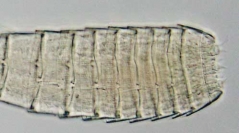

 European Journal of Taxonomy
844 (1) - Pages 1-108
European Journal of Taxonomy
844 (1) - Pages 1-108Limited data are available for the kinorhynch fauna from the Southern Hemisphere, with little or no data from New Zealand. Here, we provide a first comprehensive overview of the diversity of mud dragons, with an emphasis on species of Echinoderes from the continental slope of New Zealand, from a variety of habitats such as slopes, canyons and seamounts located in the Hikurangi Margin region. The study revealed fifteen species of Echinoderes. Of these, ten are described as new to science: E. aragorni sp. nov., E. blazeji sp. nov., E. dalzottoi sp. nov., E. frodoi sp. nov., E. galadrielae sp. nov., E. gandalfi sp. nov., E. landersi sp. nov., E. leduci sp. nov., E. legolasi sp. nov. and E. samwisei sp. nov. Moreover, Echinoderes juliae Sørensen et al., 2018, Echinoderes sp. aff. E. balerioni, Echinoderes sp. aff. E. galadrielae/beringiensis, Echinoderes sp. aff. E. lupherorum and Echinoderes sp. aff. E. unispinosus are reported in the investigated region. The most abundant among all was E. gandalfi sp. nov., but it was found only in canyons. Interestingly, the second most common species was E. juliae that was found at several stations in canyons, seamount and on the slope. This species is one of the deep-sea species originally found on the abyssal plain off Oregon and along the continental rise off California, Northeast Pacific, recorded in polymetallic nodules in the tropical eastern Pacific, and recently found on the abyssal plains off Chile, east of the Atacama Trench. These findings, together with records of Echinoderes sp. aff. E. lupherorum and Echinoderes sp. aff. E. unispinosus indicate that, despite their low dispersal abilities, kinorhynchs, similar to other meiofaunal species, may exhibit a wider distribution pattern than previously assumed. The number of recorded species and numerous new species show that New Zealand sediments not only are inhabited by a diverse kinorhynch fauna, but Echinoderes, the most speciose genus, still holds much to discover.